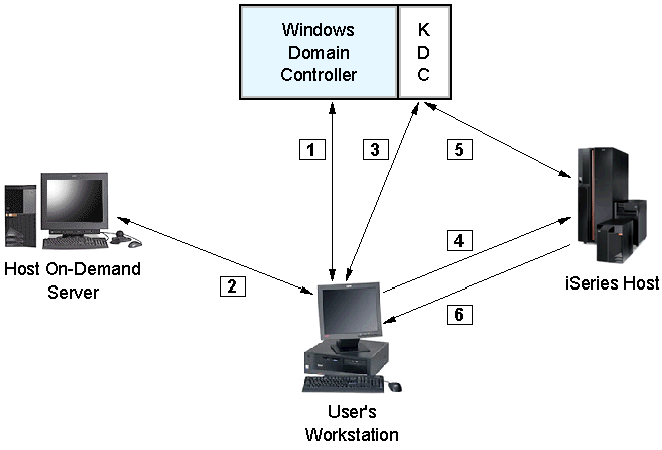

Unlike macro-based automation, connection-based automation does not require a macro because the client and the host are able to connect without having to provide the user with a login screen. In macro-based automation, a macro is required to automate this screen. Connection-based automation supports the following two environments:
Telnet-negotiated login
Currently, Web Express Logon supports OS/400 (V5R2 and later) telnet-negotiated
environments that have Kerberos authentication enabled. It does not require
the CMS, a login macro, a Network Security plug-in, nor the HCM database. Instead,
it extends the existing single sign-on capability of the OS/400 operating system.
In order for connection-based automation to function in this environment, you must have the following prerequisites in place:
You must configure your OS/400 environment to use single sign-on capability in order to implement connection-based logon automation. The OS/400 environment provides single sign-on capability through a combination of network authentication service (NAS) (opens new browser) and an IBM technology called Enterprise Identity Mapping (EIM) (opens new browser). Host On-Demand uses this existing methodology for acquiring credentials to allow users to bypass the 5250 session login screen. Both NAS and EIM technology are available with the OS/400 (V5R2 and later) operating system.
The following graphic illustrates the overall process of connection-based automation in an OS/400 environment with Kerberos authentication enabled:

FTP login
Web Express Logon provides an automated way for users to log on to FTP hosts
by providing a central repository for storing and retrieving user's credentials.
Although this process is similar to configuring Web Express Logon in a vault-style
environment (see Scenario 2: Configuring Web Express Logon in a vault-style
environment on page 65), this type of automation is different because the user's
credentials are retrieved from the CMS at the time the connection is established.
In other words, it does not require a macro. Currently, Host On-Demand allows
you to statically store a user's ID and password in the FTP configuration; however,
Web Express Logon extends this approach by automating the user credential retrieval
process.
In order to enable Web Express Logon for FTP sessions, follow the steps for Scenario #2: Configuring Web Express Logon in a vault-style environment. Look for the following icon to provide you specific information that applies to FTP sessions:
![]()
Click Next for an overview of the three real-life scenarios.